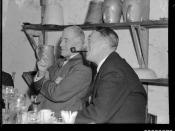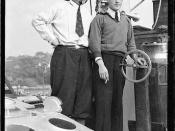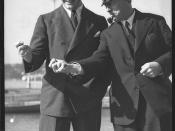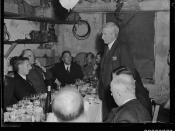Gamma ray intensity is the number of photons hitting a unit area in unit time, this is calculated through the count rate per second as count rate is proportional to Intensity. However the background count rate needs to be taken into account when determining the final count rate as there is also outside radiation illuminating on the count rate detector.
This practical will study the way in which the gamma ray intensity varies with distance from the source. Gamma rays are electromagnetic radiations which we detect as quanta of energy or photons. When the radioactive source is confined so that it acts as a point source, the reduction in the number of photons incident on a given area is such that the intensity is inversely proportional to the square of its distance from the source. This is known as the inverse square law:The distance from the gamma source to the Geiger Muller tube will be changed during the practical and the effect this has on the count rate and hence intensity.
Aim: To determine the effect of increasing distance from the source of gamma radiation on the count rate.
Hypothesis: As the distance from the source increases the count rate of the gamma radiation will decrease.
Variables:-Controlled - equipment, gamma ray source (Co-60), time in measuring count rate (1 minute),-Independent - distance (5cm, 10cm, 15cm, 20cm)-Dependent - count rate (per second)The dependent variable is a result of the independent variable being changed, i.e. as a result of the distance changing the count rate will change. The independent variable is the variable being deliberately changed i.e. distance.
Equipment:Geiger - Muller tube (GM tube)Gamma ray sourceMeter rulerStop watchScalar counterTongs/glovesMethod:NOTE:-HANDLE SOURCES WITH CARE, USE TONGS OR THICK GLOVES-DURING THE DURATION OF THE PRACTICAL STAY A PRACTICAL DISTANCE FROM THE GAMMA RAY SOURCE1.Connect the GM tube to the scalar counter.
2.Set the voltage on the GM tube to its standard settings.
3.Turn on the scalar counter and time for 3 minutes the background radiation count.
4.Record this reading for future calculations, make sure you record in counts per seconds (cps).
5.Using the meter ruler measure 5cm away from the end of the GM tube on the table and place the gamma ray source (Co-60) directly in front of it.
6.Turn the Power pack on and time for 1 minute.
7.Record the count rate reading from the scalar onto a table (count rate vs distance)(Note: as the scalar counter is only being timed for 1 minute the recorded count rate is in counts per minute, to convert to counts per second divide by 60. To find the actual count rate subtract the background count rate from the recorded count rate.)8.Carry out 3 trials and record an average.
9.Repeat steps 6-9 with distances 10cm, 15cm, 20cm.
The set up of the experiment should look as the following diagram:Results:Count Rate vs Distance of a gamma radiation light sourceDistance (cm)Count Rate (cps)Trial 1Trial 2Trial 3Average5Highest count rate per second101520Lowest count rate per secondDistance2 (cm)1/Count Rate (cps)Trial 1Trial 2Trial 3Average25Lower value100225400Higher valueResolution:Ruler- 0.001mRandom errors are identified through scatter in the data. On the graph the scatter will be seen about the line of best fit. The larger the scatter the more effect the random error had on the precision of the results.
Systematic errors show inaccuracy within the date. On the graph the line of best fit should have a y-intercept below zero because when the source is 0m away there should still be a count rate as the gamma source is within the container and there is a distance between the tip of the container and the actual gamma source.
If we plot Count Rate (y-axis) against 1/distance2 (x-axis) we will get a straight-line graph:Count rate of the distance2 from the gamma source graphNotice that the line makes an intercept with the y-axis below the origin. This is because the gamma source is deep within its container. It would clearly be most undesirable to have it exposed immediately to the room. The intercept gives us the count rate right at the source.
Calculations:Count Rate per Second (Intensity) =An error that may have occurred during the duration of the practical could be due to the fact of outside forces protruding on the practical. Due to the fact that the practical was not performed in a closed system external interferences may have varied the background count rate, this would have affected the results in that when recording the count rate obtained by the scalar counter at that time it may have had a change in background count rate, and hence when finding the actual count rate by subtracting the background count rate from the recorded count rate it would have been either greater or smaller then the true value depending on how the background count rate was changed. These external forces would have affected the precision of the practical by the forces changing the magnitude of the background count rate, and hence final count rate. The change in background count rate would have varied for each trial hence it would be a random error. To minimise this error, the background count rate should be recorded for each trial and distance.
Another Random error that may have effected the results was the decaying of the gamma ray source. Radioactive substances decay with time, therefore the emission of rays at the start of the practical would have been more then that at the end of the practical. The effect of this would cause the count rate to be less then the true value by an increasing amount as the duration of the practical increased, and therefore the intensity would have been below the true value. As the emission at the end of the practical would have been below the initial emission by a increasing amount for each trial and distance, it would be a random error hence cause scatter within the data. A way of improving this error is to use a new gamma ray source for each distance that emits the same initial rays.
Another systematic error that may have occurred when performing this practical was the distance measured between the GM tube and the gamma ray source. Due to the resolution of the ruler the distance measured needed to be rounded to the nearest millimetre. Therefore the distance may have been larger or smaller for each of the three trials. This would have resulted in inaccurate count rates for that particular distance by having higher or lower count rates consistently. Hence it would impact the overall intensity at that particular distance. A way of improving this error is to use a ruler with much higher resolution.
BibliographyAndy Darvill, (last updated 2007), http://home.clara.net/darvill/nucrad/types.htm, accessed 12/06/2008NRC, (last updated May 07, 2008), http://www.nrc.gov/reading-rm/basic-ref/teachers/unit1.html, 17/06/08bibliographyclass notes





